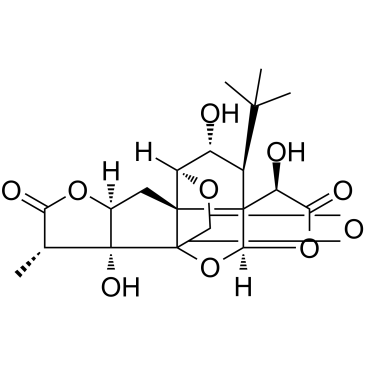Ginkgolide J

Ginkgolide J structure
|
Common Name | Ginkgolide J | ||
|---|---|---|---|---|
| CAS Number | 107438-79-9 | Molecular Weight | 424.399 | |
| Density | 1.6±0.1 g/cm3 | Boiling Point | 760.4±60.0 °C at 760 mmHg | |
| Molecular Formula | C20H24O10 | Melting Point | 41-42 °C | |
| MSDS | USA | Flash Point | 273.6±26.4 °C | |
|
Complete 1H NMR spectral analysis of ten chemical markers of Ginkgo biloba.
Magn. Reson. Chem. 50(8) , 569-75, (2012) The complete and unambiguous (1)H NMR assignments of ten marker constituents of Ginkgo biloba are described. The comprehensive (1)H NMR profiles (fingerprints) of ginkgolide A, ginkgolide B, ginkgolide C, ginkgolide J, bilobalide, quercetin, kaempferol, isorh... |
|
|
Rapid analysis of terpene lactones in extract of Ginkgo biloba L. by high performance liquid chromatography.
Se Pu 18(5) , 394-7, (2000) A new rapid analytical method was developed for the quantification of terpene lactones (bilobalide(BB) and ginkgolide A, B, C, J) in extract of Ginkgo biloba L. (EGb) using a liquid-liquid solvent extraction procedure followed by high performance liquid chrom... |
|
|
Protection against beta-amyloid induced abnormal synaptic function and cell death by Ginkgolide J.
Neurobiol. Aging 30(2) , 257-65, (2009) A new Ginkgo biloba extract P8A (TTL), 70% enriched with terpene trilactones, prevents A beta(1-42) induced inhibition of long-term potentiation in the CA1 region of mouse hippocampal slices. This neuroprotective effect is attributed in large part to ginkgoli... |
|
|
Isolation of ginkgolides A, B, C, J and bilobalide from G. biloba extracts.
Phytochemistry 65(21) , 2897-902, (2004) Ginkgolides A, B, C and J, together with bilobalide, are unique terpenoid components of the Ginkgo biloba tree. Due to similar chemical properties, their separation is quite tedious. We have developed an efficient and rapid protocol for separation of individu... |
|
|
A method for extraction and quantification of Ginkgo terpene trilactones.
Anal. Chem. 76(15) , 4332-6, (2004) A method was developed for the extraction and quantification of pharmacologically active terpene trilactones (ginkgolides, bilobalide) from the tissues of Ginkgo biloba L. and pharmaceutical ginkgo products by RP-HPLC, based on the theory of terpene trilacton... |
|
|
Ginkgolides: selective acetylations, translactonization, and biological evaluation.
J. Org. Chem. 67(13) , 4623-6, (2002) Protocols for selective acetylation of the hydroxyl groups of ginkgolide C have been developed. These acetylations have given rise to various ginkgolide C acetates and iso-ginkgolide C acetates, the latter having a rearranged skeleton resulting from translact... |
|
|
Effect of ischaemia and role of eicosanoids in release of atrial natriuretic factor from rat heart.
Cardiovasc. Res. 27(9) , 1576-9, (1993) The aim was to investigate (1) the relationship between atrial natriuretic factor (ANF) release and the extent of ischaemia-hypoxia, and (2) the potential role of eicosanoids in ANF release during global ischaemia, particularly the cyclo-oxygenase derivatives... |
|
|
Separate induction of human blood platelet aggregation or cytotoxicity by different concentrations of PAF-acether and thrombin.
Agents Actions 36(1-2) , 39-43, (1992) Using decreasing concentrations of PAF-acether or thrombin, it was possible to observe on human platelets, first, aggregation, classically associated to activation, then , below a threshold, cytotoxicity towards Schistosoma mansoni larvae, proposed here as st... |
|
|
Three ginkgolide hydrates from Ginkgo biloba L.: ginkgolide A monohydrate, ginkgolide C sesquihydrate and ginkgolide J dihydrate, all determined at 120 K.
Acta Crystallogr. C 58(Pt 3) , o195-8, (2002) A low-temperature structure of ginkgolide A monohydrate, (1R,3S,3aS,4R,6aR,7aR,7bR,8S,10aS,11aS)-3-(1,1-dimethylethyl)-hexahydro-4,7b-dihydroxy-8-methyl-9H-1,7a-epoxymethano-1H,6aH-cyclopenta[c]furo[2,3-b]furo[3',2':3,4]cyclopenta[1,2-d]furan-5,9,12(4H)-trion... |
|
|
Single-laboratory validation for the determination of terpene lactones in Ginkgo biloba dietary supplement crude materials and finished products by high-performance liquid chromatography with evaporative light-scattering detection.
J. AOAC Int. 90(3) , 647-58, (2007) A single-laboratory validation was completed for a method to determine total terpene lactones in Ginkgo biloba products. The method determines terpene lactones on the basis of the main terpene lactones (Bilobalide, Ginkgolide A, Ginkgolide B, Ginkgolide C, an... |